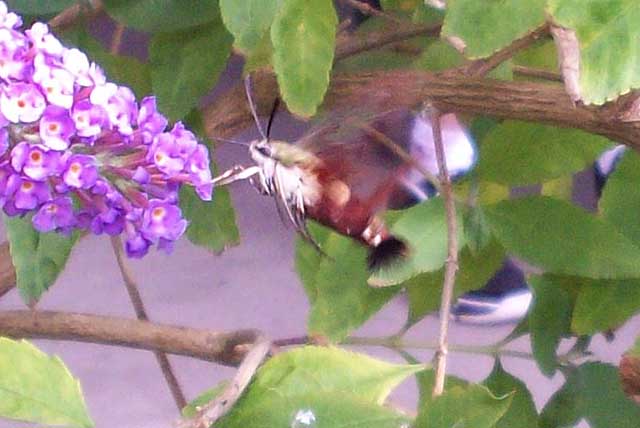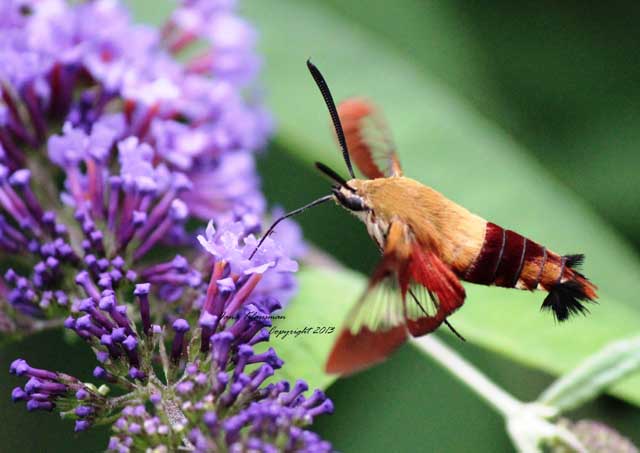Sphinginae subfamily
Sphingini tribe:
 |
Agrius cingulata,
USGS Pink-spotted hawkmoth,
stray.
This species is a strong migrant and adults nectar from
deep-throated flowers including moonflower (Calonyction aculeatum),
morning glory (Convolvulus), honey suckle (Lonicera)
and petunia (Petunia species).
|
 |
Ceratomia amyntor,
The Elm Sphinx or Four-horned Sphinx,
USGS/CL:
Fw upperside brown with dark brown and white
markings including white costal area near wing base, dark
streaks along the veins, and a white spot in the cell.
Larvae feed on Elm (Ulmus), birch (Betula), basswood (Tilia), and
cherry (Prunus).
|
Ceratomia amyntor, Forest Hills, August 5, 1996, courtesy of Curt Lehman.
 |
Ceratomia catalpae
USGS,
the Catalpa Sphinx
The upperside of the forewing is yellowish brown with no white
markings, but there are indistinct black lines and dashes. The cell
spot is gray with a black outline and the upperside of the hindwing
is yellowish brown with obscure lines.
Caterpillars feed gregariously on Catalpa species
(Catalpa bignoniodes and C. speciosa).
|
 |
Ceratomia undulosa
WO, the Waved
Sphinx:
The upperside of the forewing is pale brownish gray with wavy black
and white lines and a black-outlined white cell spot. The upperside
of the hindwing is gray with diffuse darker bands.
|
 |
The upperside of the forewing is dark brown with a dusting of white
scales. Some moths have patches of reddish or yellowish brown on the
wings.
|
 |
The upperside of the forewing is gray with heavy black bands. The
upperside of the hindwing is brownish gray with no markings.
|
 |
Lapara coniferarum
USGS, the Southern Pine Sphinx:
The upperside is of the forewing is gray with two (sometimes one or
three) black dashes near the wing center; other markings are usually
diffuse. The upperside of the hindwing is a uniform brown-gray.
doubtful, more southeasterly in PA
|
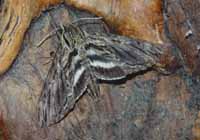 |
Lintneria eremitus
WO, the
Hermit Sphinx: Fw upperside gray-brown with wavy lines,
black dashes, and one or two small white spots near center of
costa.
Larval hosts are various species of beebalm (Monarda), mints (Mentha),
bugleweed (Lycopis), sage (Salvia).
|
 |
The upperside of forewing is gray to grayish brown with a black line
running from the middle of the costa to the middle of the outer
margin; the line may be broken near the margin. There is a splash of
brown around the cell spot.
|
 |
Manduca quinquemaculatus
WO,
the Five-spotted Hawkmoth:
The moth abdomen usually has five but sometimes six pairs of yellow
bands. The upperside of the forewing is blurry brown and gray.
I suspect if you grow tomatoes, you are likely to encounter it.
|
 |
Manduca rustica
WO, possible stray from further south, the Rustic Sphinx.
The abdomen of the adult moth has three pairs of yellow spots. The
upperside of the forewing is yellowish brown to deep chocolate brown
with a dusting of white scales and zigzagged black and white lines.
possible stray
|
 |
The abdomen usually has six pairs of yellow bands, broken across the
back. The sixth set of markings is quite small.
The upperside of the forewing has indistinct black, brown, and
white markings.
|
 | The upperside of the forewing is gray with indistinct black and
white markings. There is a series of black dashes
from the base to the tip, and a small white cell spot.
|
 |
Sphinx chersis
USGS,
the Northern Ash Sphinx or Great Ash Sphinx:
Fw upperside soft dark gray to blue-gray with
series of black dashes, one of which reaches wing tip.
Larval hosts are ash, lilac, privet, cherry, quaking aspen.
|
 |
Forewings, long and slender, are held close to the body when the
moth is at rest. Larvae are beautiful and feed on cherry foliage.
|
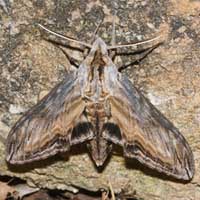 |
This species is not widely reported anywhere.
Similar to S. kalmiae but
lacks the dark bar along the fw inner margin. questionable, northern range border
|
 |
The upperside of the forewing ranges from brown with black borders
through brownish gray with paler borders to pale gray with no
borders. Dashes, submarginal line, and cell spot are usually weak.
|
 |
The lower forewings are predominantly brownish-yellow with a fairly
wide dark bar along the inner margin. At rest the wings hug the body,
giving the moth a long slender look.
|
 |
Sphinx luscitiosa
WO, possibility, but generally more northerly,
the Canadian Sphinx or
Clemen's Sphinx
The upperside of the forewing is yellowish gray in males and pale
gray with a faint yellow tint in females. In both sexes, the dark
border on the outer margin widens as it approaches the inner margin.
|
Smerinthini Tribe:
 |
The adults are also highly variable; sometimes wings of an individual
may be all one color or may have several colors, ranging from pale to
dark brown, and may have a white or pink tinge. Patterns range from
faint to pronounced.
|
 |
Pachysphinx modesta
USGS,
the Modest Sphinx or Poplar Sphinx
This moth has a large, heavy body, and females can be remarkably
plump.
Larvae are fond of poplars and willows.
|
 |
This appears to be an uncommon species. The outer margin of the forewing is nearly straight.
|
 |
Paonias excaecata
USGS,
the Blinded Sphinx:
Named for the dull grey-blue spot (minus dark pupil) in the hindwing,
this moth has a wide distribution and is probably common in Wayne
County.
I regularly see them on Prince Edward Island, and they are reported
as far south as Florida. |
 |
Paonias myops
USGS, the Small-eyed Sphinx
Named for the small eye-spot in the hindwing, this moth has a wide
distribution and is probably common in Franklin County.
I regularly see them on Prince Edward Island, and they are reported
as far south as Florida.
|
 |
This moth is widely distributed and fairly common.
Along the East Coast, it flies from P.E.I. to Florida.
|
 |
Smerinthus cerisyi
WO, possibility, but generally more northerly, the Cerisyi's Sphinx
At my home in Montague, P.E.I., Canada, they are quite common.
I expect they might also be present in Allegheny County, but that would be a southern range border in
PA. |
Macroglossinae subfamily
Dilophonotini tribe:
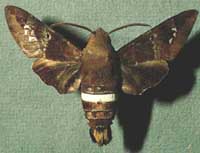 |
Aellopos clavipes
WO, the Aellopos Sphinx.
The body is dark brown with a wide white
band across the abdomen. Wings are dark brown. The forewing has a
black cell spot and 3 white spots near the pale brown marginal
area. Note absence of white scales near hindwing anal angle.
possible rare stray
|
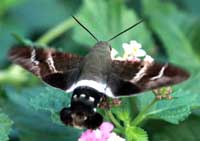 |
Aellopos titan
USGS, the Titan Sphinx.
The body is dark brown with a wide white stripe across the abdomen.
The wings are dark brown. It is very similar to above species, but the
upperside of the hindwing has
pale patches along the costa and inner margin. probably misidentification, more likely rare clavipes or fadus or tantalus stray
|
 |
Erinnyis ello USGS, the Ello Sphinx:
Abdomen: very distinct gray and black bands. Female's fw upperside: pale gray with few dark dots near outer margin. Male's fw upperside:
dark gray and brown with a black band running from base to tip. Hw upper is orange with wide black border.
adult stray
|
See Hemaris comparison to help distinguish
the next three species.
 |
Hemaris thysbe
MM,JM/USGS, the Hummingbird Clearwing:
It is not difficult to see why many gardeners would mistake an
Hemaris thysbe moth for a small hummingbird as it hovers,
sipping nectar from flowers through a long feeding tube.
|
Hemaris thysbe, Pittsburg, September 4, 2010, courtesy of Maggie Monroe, via Jackie Monroe.
Hemaris thysbe, Pittsburg, July 27, 2013, Jana Klausman.
 |
Hemaris diffinis
USGS, the
Snowberry Clearwing or Bumblebee Moth
Adults mimic bumblebees and are quite variable, both geographically
and seasonally. The thorax is golden-brown to
dark greenish-brown. The abdomen tends to be dark (black) with
1-2 yellow segments just before the terminal end.
|
 |
Hemaris gracilis
USGS, the
Slender Clearwing or Graceful Clearwing
Hemaris gracilis is distinguished from similar species by a pair of
red-brown bands on the undersides of the thorax, which varies from
green to yellow-green dorsally and sometimes brown with white
underneath. They have a red abdomen.
|
Philampelini tribe:
 |
Eumorpha achemon
USGS,
the Achemon Sphinx:
Adults nectar from flowers of Japanese honeysuckle
(Lonicera japonica), petunia (Petunia hybrida), mock
orange (Philadelphus coronarius), and phlox (Phlox).
If you have Grape or Virginia Creeper nearby, then you probably have
this species.
|
 |
If you have Grape or Virginia Creeper nearby, then you probably have
this species.
|
Eumorpha pandorus, Pittsburg, September 4, 2012, Jana Klausman.
Macroglossini tribe:
 |
This day flier is widely distributed. If you have Virginia Creeper,
you probably have the Nessus Sphinx. Two bright, distinct, narrow
yellow bands are often visible on the abdomen.
|
 |
They are common in Pennsylvania and common
here on Prince Edward Island.
You will often see this species listed as Darapsa pholus,
especially in older literature. Hindwings are the same colour as the abdomen.
|
 |
Darapsa myron
USGS, the Virginia Creeper Sphinx or the
Grapevine Sphinx.
Fw upperside dark brown to pale yellowish gray, with an
olive tint. On costal margin there is dark rectangular patch,
although this may be reduced or absent. Hw upperside is pale orange.
|
 |
If you have hydrangea growing near a stream, then you may have the
Hydrangea Sphinx. If it is present, it probably is not common.
|
 |
This small species flies in the early spring.
Grape (Vitis), ampelopsis (Ampelopsis), and Virginia creeper (Parthenocissus) all serve as larval hosts.
|
 |
Hyles gallii
USGS, the Bedstraw Hawk Moth
or Gallium Sphinx
generally further north, southern range limit in PA
|
 |
Hyles lineata
USGS, the White-lined Sphinx
The forewing upperside is dark olive brown with paler brown along the
costa and outer margin, a narrow tan band running from the wing tip
to the base, and white streaks along the veins.
|
 |
This moth is very much under reported across the United States. It
is a rapid day flier so is probably not in too many collections.
Grape is a popular larval host.
|
 |
This moth is much more common to the south. It is a strong migrant,
however. likely as a stray from further south or east
|
|
|
